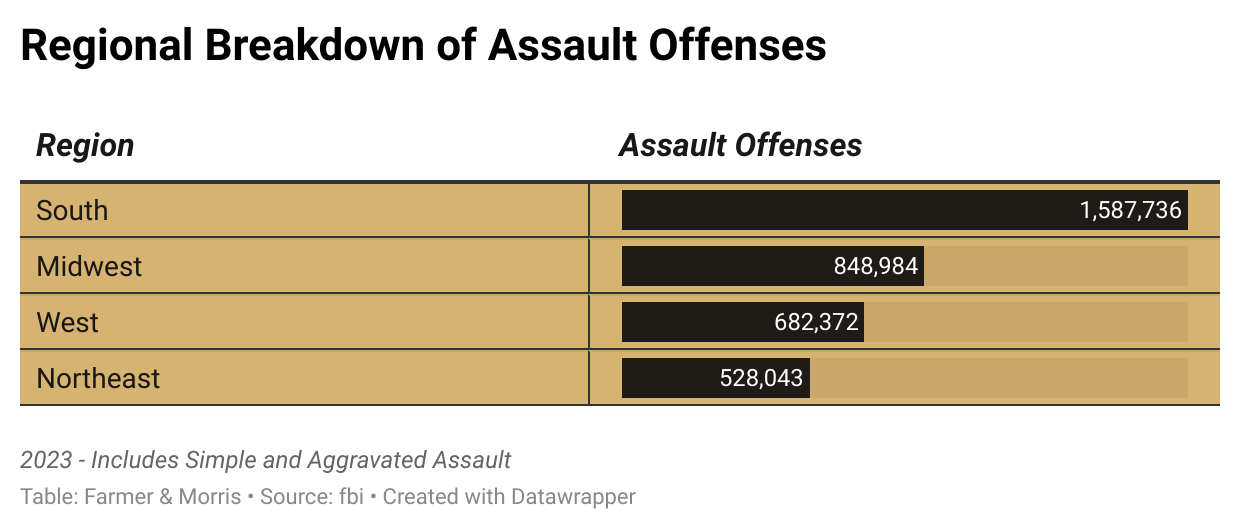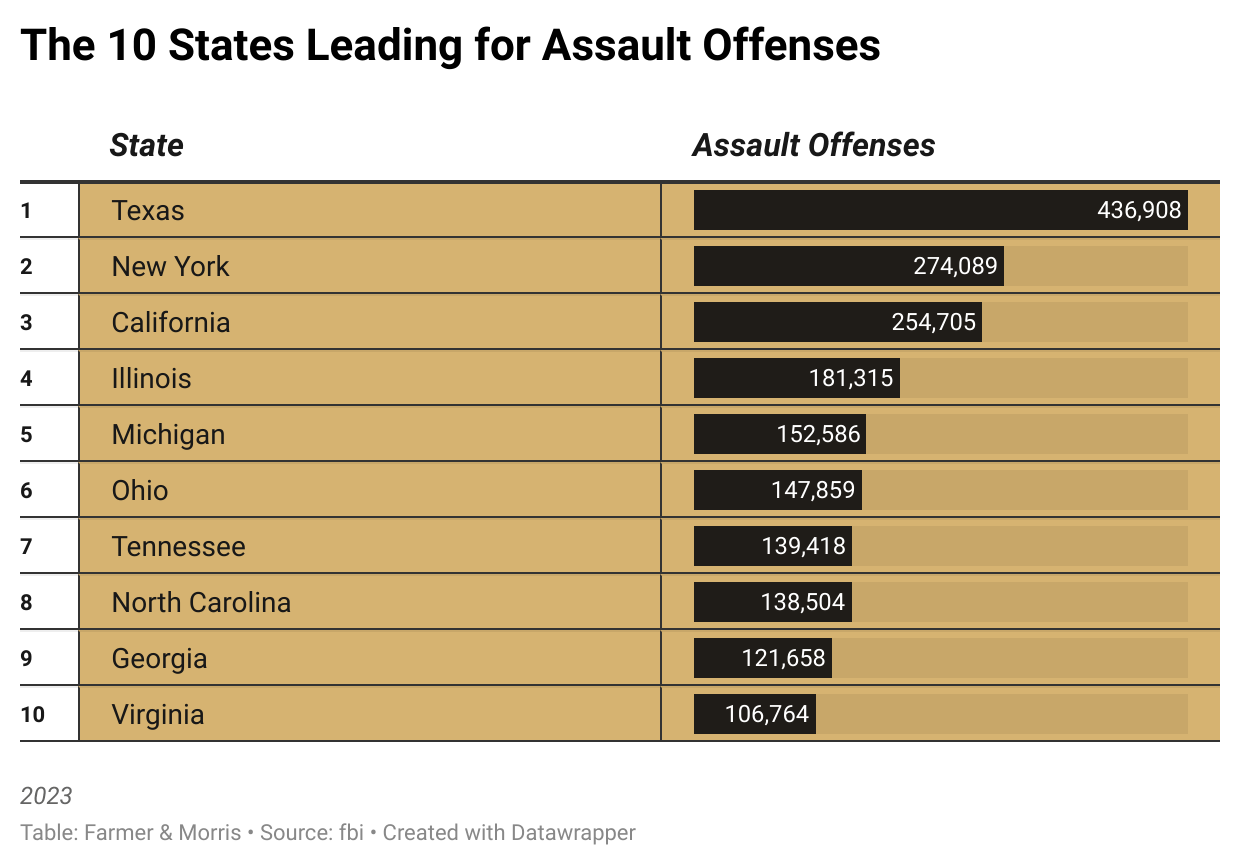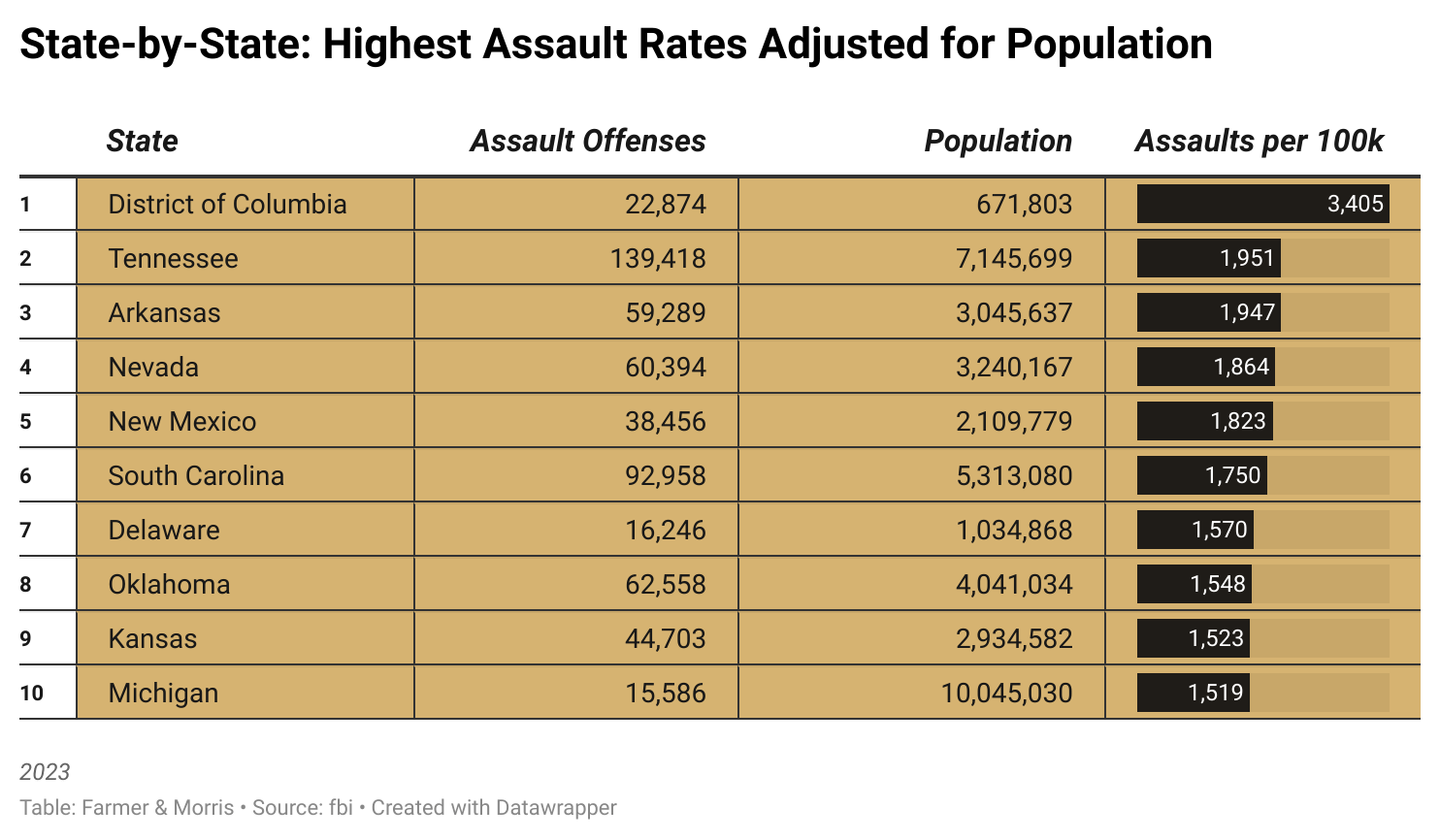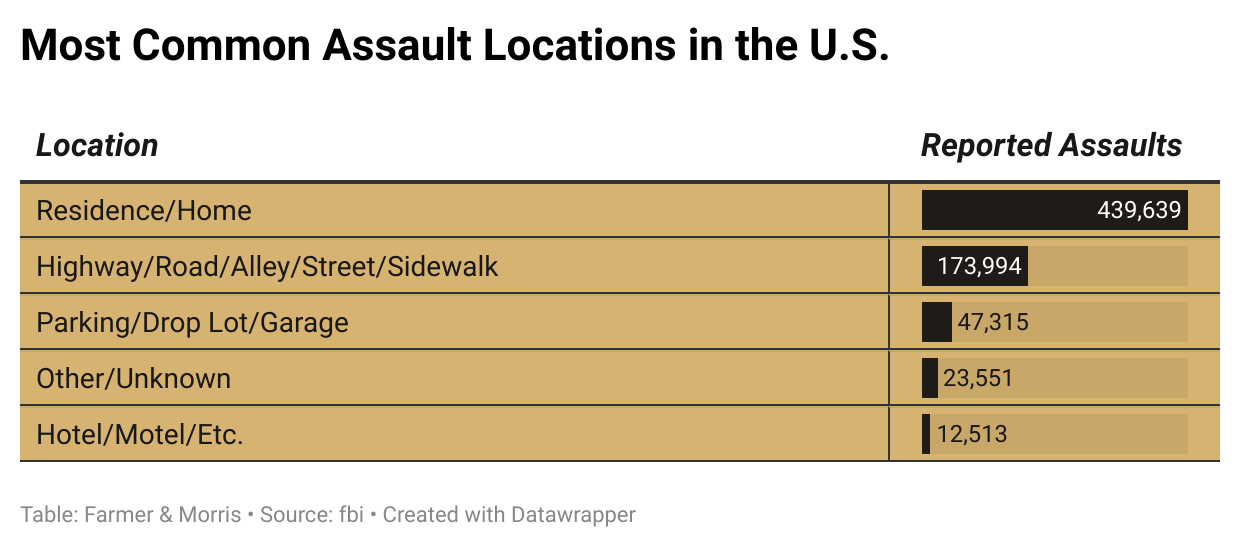Across the U.S. in 2023, 2,437,206 simple assault cases were reported, plus 818,908 aggravated assaults. Simple and aggravated assault represent two very different assault levels. As defined by the FBI, simple assault involves a physical attack or threat without a weapon that doesn’t cause serious injury – think of a shove or a slap, the kind of assault that, at worst, leaves minor bruises.
On the other hand, aggravated assault includes attacks intended to inflict severe harm, often involving a weapon such as a gun or knife.
This study will consider the parts of the country most afflicted by assault, plus the specific locations where most assaults are carried out. And we’ll look at what might be done to lower assault numbers at a time when violent assault is an unfortunate part of everyday American life, with weapon use across the country also currently rife.
Aggravated Assault: A Rising Threat To Public Safety In The U.S.
According to 2023 study data, the vast majority of simple assaults (about 1.9 million) involved weaponized body parts such as fists or feet, while aggravated cases were far more likely to include actual weapons like firearms or sharp objects.
Although both assault types often occur in homes or on streets, simple assault is far more common; though rarer, a case of aggravated assault poses a far greater threat to personal safety, due to the involvement of a dangerous weapon.
Weapons
As aggravated assault typically involves the use of a weapon, let’s consider the types of weapons most commonly involved.
2023 data reveals a mix of firearms and physical force. Topping the weapons list are handguns, which were used in 165,261 incidents; weaponized body parts, such as fists, hands, and feet, were used in 161,409 cases.
These statistics offer a useful comparison by underscoring how frequently assaults are carried out using physical force, as well as by employing external weapons.
Knives and cutting instruments were the third most frequently used weapons (131,764 incidents), a statistic that highlights the persistent threat posed by readily available sharp objects. An additional 103,799 assaults involved a firearm of an unspecified type, and the category ‘other weapons’, which incorporates improvised or uncommonly used items, accounted for 80,703 cases.
Combined, these five categories represent the overwhelming majority of weapon-related assaults. The data emphasizes the need for both firearm violence prevention and conflict management strategies, especially regarding incidents involving hand-to-hand violence or everyday objects used for dangerous purposes.
And the data featured in the following breakdown shows us that one particular region suffered a disproportionate problem regarding assault figures.
Regional Assault Offense Data
In 2023, the different regions of the United States experienced significant disparities regarding assault offenses, with the South suffering the most assaults by a substantial margin.
According to statistical data, the South recorded 1,587,736 assault offenses, a large portion of the nation’s total and nearly double that of the Midwest’s assault figures (848,984 offenses). The South’s assault numbers also represented more than double the West’s (682,372) figure, and nearly three times the assault numbers posted by the Northeast (528,043 offenses).
These disparities emphasize the extent to which assault offenses are geographically concentrated. The South’s total alone accounts for over 43% of all U.S. assaults, which suggests the need for region-specific interventions.
While multiple factors (including population size, poverty rates, access to guns, and regional reporting practices) may contribute to the South’s anomalous figures, the scale of violence in the South demands targeted public safety strategies, community-based prevention programs, and policy reform.
By comparison, the Northeast, despite featuring some of the most densely populated urban centers, reported significantly fewer assaults. This suggests differences in enforcement, infrastructure, or underlying social dynamics.
Ultimately, it should be possible to use a regional comparison as a foundation for further investigation into the causes behind assault trends. And, looking at things at a regional level underscores the need to use geographical context when tailoring crime prevention efforts.
State Assault Offense Data
In 2023, assault offenses were highly concentrated among a small group of U.S. states, with the top 10 states accounting for a significant share of the national total.
Texas led the country’s assault numbers, reporting 436,908 offenses, a figure that far outstripped any other state. New York suffered the second highest number of assaults (274,089), with California just behind in third with 254,705; both sets of numbers reflect states with large populations and dense urban centers.
Further down the list, the Midwest is heavily represented, with Illinois (181,315), Michigan (152,586), and Ohio (147,859) each significant contributors to the nation’s assault count.
Perhaps unsurprisingly, Southern states dominated the rankings, claiming six of the top ten spots. As well as Texas, Tennessee (139,418), North Carolina (138,504), Georgia (121,658), and Virginia (106,764) all reported high assault totals. This regional pattern aligns with broader crime trends, where the South consistently sees elevated rates of violent attacks.
The data underscores not only the sheer volume of offenses but also regional disparities that may be influenced by a variety of factors: they include population size, economic inequality, access to mental health care, and local policies.
These top 10 states should be a focal point for ongoing public safety efforts, policy development, and community-based violence prevention programs that address the root causes of high assault rates.
State Assault Offenses Measured By Population
Based on 2023 data, the 10 states with the highest assault offenses per 100,000 residents reveal a striking concentration of violence in specific regions, particularly the South and Southwest.
Measured by population, the state that leads the nation’s assault figures by a wide margin is the District of Columbia, with an astounding 3,405 assaults per 100,000 people. That’s more than 1.5 times higher than second-placed state Tennessee (1,951), with Arkansas (1,947) in third place. These three sets of figures further highlight the South’s continual struggle with high interpersonal violence rates.
States like Nevada (1,864), New Mexico (1,823), and South Carolina (1,750) also rank highly. This reinforces previously seen violent crime report patterns that show elevated assault rates in states featuring economic inequality, high urbanization, or under-resourced public health systems.
Smaller states such as Delaware (1,570) and Kansas (1,524) also feature in the top 10, indicating that population size alone doesn’t determine assault frequency. Michigan (1,519) and Oklahoma (1,548) complete the list, further augmenting the Midwest’s growing presence when it comes to violent offense statistics.
Overall, this per capita analysis emphasizes that assault offenses are never just a matter of raw numbers and reflect deeper regional and systemic issues that persist regardless of state size. These insights are crucial to help guide targeted violence prevention strategies and allocate resources where they’re most needed.
The Places Where Most Assaults Happen
In 2023, the majority of assaults in the U.S. were carried out in a small number of familiar, everyday settings. By far the most popular places were residences and homes, with over 439,000 reported incidents representing more than double the number of assaults that took place anywhere else. This emphasizes the fact that domestic violence continues to be a major contributor to overall assault statistics.
The second most common location for assaults was public roadways and sidewalks, with approximately 174,000 incidents, numbers that emphasize the frequency of altercations in transit areas like streets, alleys, and sidewalks.
Parking lots and garages were also popular assault sites (47,315 incidents), suggesting that these often overlooked spaces remain hotspots for conflict, likely due to poor lighting, limited security, and isolated conditions.
An additional 23,551 incidents were classified as ‘Other/Unknown’, reflecting data collection gaps and incidents occurring in unconventional or unclassifiable environments. Rounding out the top five were hotels and motels (12,513), which may reflect disputes among guests, domestic violence in a temporary location, or substance-related incidents.
This breakdown highlights the fact that assaults don’t just happen down dark alleys at night. Instead, they often occur in the familiar spaces where people live, travel, and frequently interact.
Understanding where incidents happen is essential to helping shape prevention strategies, improving public safety infrastructure, and deploying resources to the most vulnerable environments.
Personal Injury Lawyer Near Me (828) 286-3866
How To Improve Assault Statistics In The United States
In 2023, the U.S. recorded over 3.25 million assault offenses: 2,437,206 simple assaults and 818,908 aggravated assaults. While simple, unarmed assaults involving minor injuries were nearly three times as common, aggravated assaults posed greater danger and often involved weapons that inflicted serious harm.
Regionally, the South led the nation with 1.58 million assault offenses, over 43% of the national total. The Midwest (848,984) and West (682,372) followed, while the least violent region, the Northeast, suffered the fewest offenses (528,043).
Per capita, the District of Columbia had the highest assault rate (3,405 per 100,000 residents), followed by Tennessee and Arkansas, underscoring regional disparities driven by factors like poverty, firearm access, and limited public health resources.
The South’s total alone accounts for over 43% of all U.S. assaults, which suggests the need for region–specific interventions.
And, at the state level, Texas, New York, and California reported the highest raw totals, with six of the top ten states from the most dangerous region, the South. Most assaults occurred in everyday spaces, with residences, streets, and parking lots topping the list, highlighting the domestic, communal nature of violent assaults.
Overall, the data emphasizes the need for a number of things. Firstly, targeted, region-specific prevention strategies are key, with the South in particular urgently needing measures to curtail extreme levels of violence and use of dangerous weapons.
Stronger community safety infrastructure is also vital, with most assaults occurring in familiar domestic or domestic-adjacent places. And policy efforts that address the underlying causes of violence across all demographics would preclude the use of the aforementioned dangerous weapons. Without any kind of further intervention, millions of Americans will continue to face the routine threat of assault, both small and aggravated.
At Farmer & Morris Law PLLC, we’re well aware of the danger all weapons represent and the devastating effects of assault. As personal injury experts, we promise to go to work optimizing your lawsuit and maximizing your potential compensation package while you focus on maximizing your physical recovery.
Get in touch with us today so we can get started on your case.







